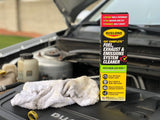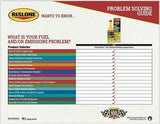
Description:
Introducing Rislone Cat Complete Fuel, Exhaust & Emission System Cleaner – the most advanced catalytic converter and emissions product available anywhere.
This formula is engineered to help you clean dirty catalytic converters, clear common OBD check engine light (CEL) codes, pass emissions testing and improve the overall health and performance of your fuel system.
Cat Complete Fuel, Exhaust & Emissions System Cleaner has high-performing detergents and heavy-duty cleaning solvents that effectively scrub and remove contaminants, soot, carbon build-up, and oily residue from the fuel injectors, combustion chambers, turbo, EGR, catalytic converters, oxygen sensors and exhaust. This, along with other active chemical ingredients, react with the gases created in the combustion process to remove the remaining inorganic deposits. This restores lost function, and with regular use, maintains efficiency.
As fuel is burned contaminating pollution is created that is circulated throughout various vehicle components. The system is designed to be able to handle this during most normal engine operation. The use of poor quality fuel, short driving distance, cold weather, improper maintenance, and component failure can greatly increase the amount of contamination and deposits created inside these systems. This can cause increased exhaust emissions, reduced fuel economy, lost power & performance, drivability issues, engine overheating, hard starts, check engine light illumination and premature engine wear.
Other benefits of Cat Complete Fuel, Exhaust & Emission System Cleaner are:
- Cleans fuel and exhaust system – reduces excess exhaust hydrocarbon, CO and NO X emissions and saves gas.
- Contains outstanding synthetic detergents to remove IVD intake valve deposits, CCD combustion chamber deposits and other fuel deposits.
- Includes combustion catalyst for improved gas mileage, smoother idling, drivability and better throttle response.
- Reduces zinc and phosphorus catalyst contamination, restoring catalytic converter function.
- Cleans O2 Lambda oxygen sensor tip.
- Clears OBD OBD-II PID CODES P0420 P0421 P0430 P0431 and turns off Check Engine Light (CEL).
- Deodorizes Sulphur (rotten eggs) exhaust smell.
- Helps pass emissions smog test, guaranteed.
- 50 state legal – EPA registered.
- Will not void manufacturer’s new vehicle warranty.
- Specifically designed and safe to use on vehicles which have oxygen sensors and catalytic converters. Exceeds EPA compliance performance criteria.
- Works on all fuel injected, direct injected, carbureted, turbo, GTDI, Ecotec® & EcoBoost® engines.
- Safe to use on all domestic, import, car, SUV, truck, hybrid and E10/E15 ethanol fuels.
If you are struggling with a persistent Check Engine Light (CEL) due to a dirty catalytic cleaner, poor gas mileage and throttle response, or passing a state-mandated emissions test, Rislone Cat Complete Fuel, Exhaust & Emission System Cleaner is a simple, effective and affordable solution that anyone can install – no special expertise needed.
Overview:
- Turn Off Check Engine Light
- Clear P0420 & Other OBD Codes
- Cleans & Resolves Catalytic Converter
- Reduces Emissions & Saves Gas









